I. Introduction
The Chicken Egg Situation Report presents the industry situation in terms of volume of production, inventory by chicken type, and monthly average farmgate prices. It serves as a ready reference for the various clients and stakeholders of the Philippine Statistics Authority (PSA) in the agriculture sector.
The data for this report were collected by PSA through the two surveys, namely, Backyard Livestock and Poultry Survey (BLPS) and the Commercial Livestock and Poultry Survey (CLPS).
The BLPS aims to generate estimates on the supply and disposition of livestock and poultry commodities at the household level. In Q4 2022, the number of sample households covered was 21,501 from the 1,145 sample barangays nationwide. On the other hand, the CLPS seeks to generate estimates on the supply and disposition of livestock and poultry commodities from the sample establishments. There were 691 layer sample establishments covered in 2022.
Both surveys are conducted quarterly in all provinces including National Capital Region. Moreover, the commodities covered in the surveys include: cattle, carabao, swine, goat, chicken, duck, and other animals raised/tended by households and establishments.
II. Data Collection
Backyard Livestock and Poultry Survey
Data collection procedure
The field data collection for fourth quarter 2022 was conducted from 01 to 07 December 2022. The data collection was undertaken by hired Statistical Researchers (SRs) and is done through face-to-face interview with qualified respondents of the sample households. Prior to data collection, training of selected staff from Field Offices, including SRs, was conducted to ensure uniform understanding of concepts and proper implementation of survey procedures. Field and manual editing of the accomplished questionnaires was done to ensure completeness, consistency, and reasonableness of the information gathered.
Survey Questionnaire
The BLPS Questionnaire is a thirteen-page form composed of 16 blocks that aims to gather information on the basic characteristics and operations of the household.
The data items included in the survey are as follows:
Type of Operation/Purpose
Inventory
Number of hatched live
Number of acquired animal
Dressed in the household/farm
Sold live for dressing and for other purposes
Disposition by areas of destination
Average liveweight
Average farmgate price
Number of deaths/losses and cause/reason
Egg production indicators
Egg disposition
Commercial Livestock and Poultry Survey
Data collection procedure
The schedule of field data collection was during the last ten (10) days of November 2022. The data collection was undertaken by hired Statistical Researchers (SRs) and is done through a face-to-face interview with qualified respondents of the farm/establishment. Prior to data collection, training of Field Office personnel, including SRs, was conducted to ensure that the procedures and concepts of the survey are understood and properly implemented. Field and manual editing of the accomplished questionnaires was done to ensure completeness, consistency, and reasonableness of the information gathered.
Survey Questionnaire
The CLPS Layer Chicken Survey Questionnaire is a two-page questionnaire that aims to gather necessary information on supply and disposition of layer commercial farms/establishment.
The data items included in the survey are as follows:
Type of Operation/Purpose
Inventory
Number of hatched live
Number of acquired animals
Dressed in the farm/establishment
Sold live for dressing and for other purposes
Disposition by areas of destination
Average liveweight
Average farmgate price
Number of deaths/losses and cause/reason
Egg production indicators
Egg disposition
III. Sampling Design
Backyard Livestock and Poultry Survey
Sampling Frame
The BLPS sampling frame is based on the results of the 2017 Listing of Farm Household (LFH) and 2012 Census of Agriculture and Fisheries (CAF). For barangays not covered in the 2017 LFH, the list of households was taken from the 2012 CAF. The sampling frame is updated quarterly based on the status of the sampled households using the structured Frame Maintenance Form (FMF) submitted by the PSOs every quarter.
Sample Selection Procedure
The BLPS uses two-stage sampling design. The first stage is the selection of barangays using probability proportional to size where the measure of size is the total animal inventory. The number of sample barangays is based on a target coefficient of variation of five (5) percent. The sample barangays are the same for all quarters of 2022.
The second stage is the selection of sample households that are engaged in livestock and poultry raising in the sampled barangays using systematic sampling.
The number of sample households per selected barangay is 20 but this could be less if the selected barangay has less than 20 households. The sample households per quarter are independent.
Estimation Procedure
a. Sampling Weights
a.1. Base Weight
The base weight is computed as follows:
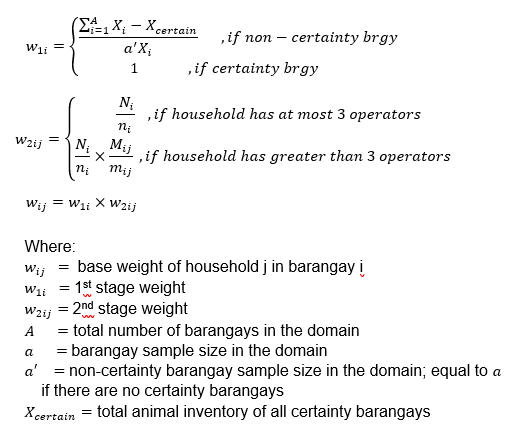

a.2. Adjustment Factor
The adjustment factor formula is given as follows:
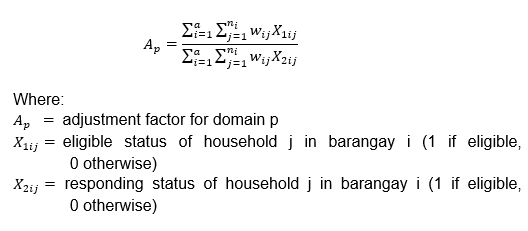
Eligible households are the following:
Interview completed;
Refused to be interviewed without replacement;
Temporarily away/Not at home without replacement; and
HH temporarily not accessible without replacement.
Ineligible households are the following:
Resides outside the barangay;
Unknown in the locality; and
Deceased (No other livestock and poultry operator in the household).
a.3. Final Weights
The final weights formula is given as follows:
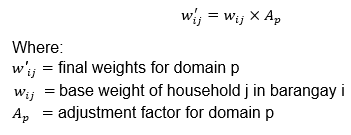
b. Estimation of Total
b.1. Estimation of Provincial Total
Estimation of domain total is done per animal type and the formula is given as follows:

b.2. Estimation of Regional and National Total
The regional estimates are obtained by aggregating the estimates of the provinces within the region, while the national estimate is derived by adding all the regional estimates.
Commercial Livestock and Poultry Survey
Sampling Frame
The CLPS frame is based on the results of the 2021 Updating of the List of Establishments (ULE). It is updated quarterly based on the results of visit of the sample establishments using the Frame Maintenance Form (FMF
Sample Selection Procedure
The CLPS uses a stratified sampling design with the maximum farm/housing capacity as stratification variable. Stratum boundaries are obtained using Dalenius-Hodges method. Sample size is determined using Neyman procedure with a target coefficient of variation of five percent (5%). A minimum of five (5) samples are taken when the population for the stratum is greater than or equal to five (5). For stratum with population less than five (5), all farms will be enumerated. The number of strata per province ranges from two (2) to four (4) depending on the homogeneity of the stratification variable.
Complete Enumeration (CE) is applied for provinces with less than 25 commercial farms/establishments, otherwise, stratified sampling design is used.
Estimation Procedure
a. Sampling weights
a.1. Base Weight
The base weight for CLPS is computed by animal type and province. The formula for base weights is given as follows:
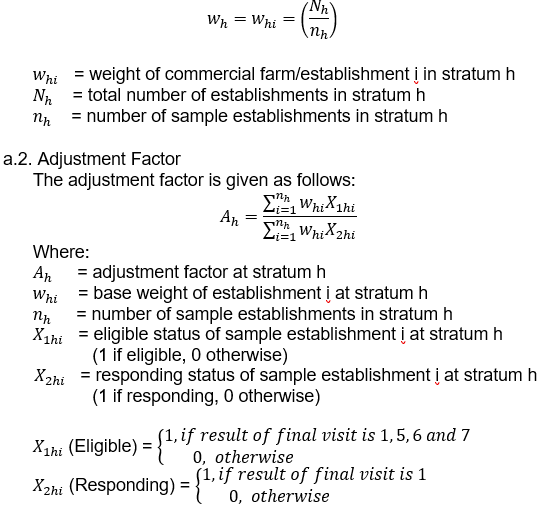
Eligible establishments are the following:
Operational
Refusal
Cannot be contacted/Not accessible/Temporarily away
Ineligible establishments are the following:
Temporarily Stopped Operation
Permanently Closed/Stopped Operation
Shifted Farm Operation
Cannot Be Located
Not yet in operation
Duplicate
Out-of-scope – Recreation
Out-of-scope – Change Sector
Out-of-scope – Main Office/Ancillary Unit
a.3. Final Weights
The final weight formula is given as follows:

b. Estimation
b.1. Estimation by Stratum
Each stratum yields an independent estimate. The formula to be used is given as follows:
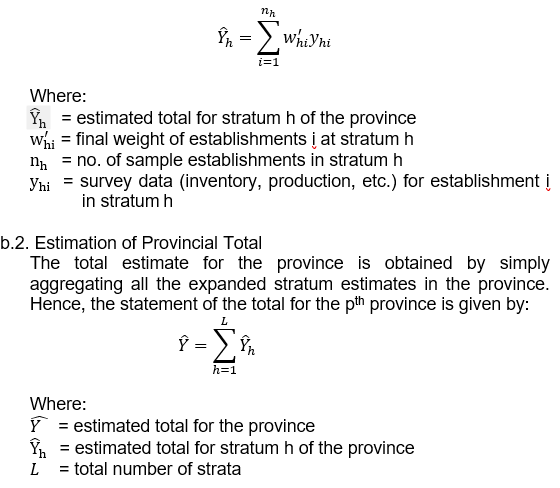
b.3. Estimation of Regional and National Total
The regional estimates are obtained by aggregating the estimates of the provinces within the region, while the national estimate is derived by adding all the regional estimates.
IV. Concepts and Definitions of Terms
Farmgate price refers to the price received by raisers for their produce at the location of farm. Thus, the marketing costs, such as the transport and other marketing costs (if any) incurred in selling the produce, are not included in the farmgate prices.
Inventory refers to the actual number of chicken laying flock and native/improved adult female present in the farm as of a specific reference date.
Volume of production refers to the volume of chicken egg disposed from locally-raised duck including those chicken eggs which were shipped out to other regions/provinces.
V. Dissemination of Results and Revision
The PSA disseminates the Chicken Egg Situation Report quarterly and is uploaded in the PSA Website.
The livestock and poultry statistics follows the revision policy as stipulated in the PSA Board Resolution No. 1, Series of 2017-119 approving the revision of quarterly estimates on agricultural production, prices, and related statistics to be limited to the immediately preceding quarter and for the past three years with quarterly breakdown to be done only during May of the current year.
VI. Citation
This presents how the Technical Notes will be cited by users in their research works. It contains the following information:
Philippine Statistics Authority
Date of Publication/Release of the Technical Note
Title of the Technical Notes
Link to the Technical Notes
VII. Contact Information
Ms. Marisol T. Fallarme
(Supervising Statistical Specialist)
Officer-In-Charge
Crops Statistics Division
Economic Sector Statistics Service
Sectoral Statistics Office
Philippine Statistics Authority
Email Address: m.fallarme@psa.gov.ph
For data request, you may contact the:
Knowledge Management and Communications Division
(632) 8462-6600 locals 820 or 823
Email Address: info@psa.gov.ph
